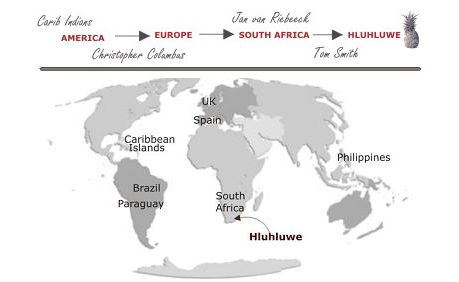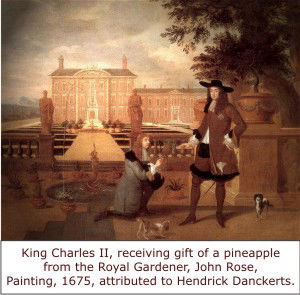AMERICA
HOW DID PINEAPPLES GET TO HLUHLUWE?

EUROPE
SOUTH AFRICA
HLUHLUWE
The Hluhluwe Queen Pineapple Marketing Association was established on
11 November 1988 to promote pineapples.

AMERICA
EUROPE
SOUTH AFRICA
HLUHLUWE
Throughout the human history of the Americas the pineapple has served as both a food and a symbol. Originally unique to the Western Hemisphere, the fruit was a culinary favorite of the fierce Carib Indians.
However the presence of pineapples on Caribbean islands was not a natural event, but rather the result of centuries of Indian migration and commerce. Tribes (as accomplished dugout canoe navigators) explored, raided and traded across tropical oceans, seas and river systems.
The Guarani Indians domesticated the plant in the dry uplands of Brazil and Paraguay from where it spread to other parts of South America and the Caribbean. They called the herbaceous plant “anana” or “excellent fruit” and highly regarded it for its intense sweetness. The “excellent fruit” was a staple of Indian feast and rites related to tribal affirmation. It was also used to produce Indian wine. They drank pineapple as an aid to digestion and a cure for bellyache, particularly when feasting on meat. Women used it as a cleanser to improve the texture of their skin. Warriors even treated wounds with pineapple flesh to promote healing. The islanders also found that concentrated preparations remove body hair, because bromelain hydrolyses protein, the keratin of hair.
The earliest written record of pineapples dates from Columbus’s arrival on Guadeloupe in November 1493. This was the first documented encounter between an European and a pineapple. Christopher Columbus was on his second voyage to the Caribbean region, anchored in a cove off the lush, volcanic island of Guadeloupe when he went ashore to inspect a deserted Carib village. There, amidst parrot-flecked jungle foliage and wooden pillars spiraled with serpent carvings, his crew came upon cook pots filled with human body parts. Nearby were piles of freshly gathered vegetables and fruits, including pineapples. The European sailors ate, enjoyed and recorded the curious new fruit, which had an abrasive, segmented exterior like a pinecone and a firm interior pulp like an apple – hence the name pineapple.
Christopher Columbus was so impressed with it that he took it back to Queen Isabella of Spain. Thereafter, pineapples became very popular in Europe, because there were not many sweets around, so people settle their craving for sweets by eating pineapples!
The Spanish introduced it into the Philippines and may have taken it to Hawaii and Guam early in the 16th century. The pineapple reached England in 1660 and only began to be grown in greenhouses for its fruit around 1720. Thus, into the 1600s the pineapple remained so uncommon and coveted a commodity that King Charles II of England posed for an official portrait in an act then symbolic of royal privilege – receiving a pineapple as a gift.
But by the end of the 16th century pineapples found its way into the European culture, and cultivation of the plant had spread to most tropical areas of the world. The stock came from wild varieties that produced small apple-sizes fruit; bore seeds and looked like a cone from a pine tree.
Because the rich cultivated pineapples in hot houses, it became a symbol of hospitality and wealth in both European and Asian cultures. The Chinese of Southeast Asia still believe the pineapple to be the symbol of prosperity.
In Europe the pineapple was a prized delicacy that graced the tables of the nobility and the wealthy. To keep up with supply, pineapples were cultivated in hot green houses in the 17th and 18th centuries. During this period British gardeners gradually refined the stock producing to the large, seedless varieties of today. Improved stock from Britain was sent to Australia, the West Indies, India and other tropical and sub-tropical regions, so that much modern stock is derived from the improvements introduced by British gardeners’ centuries ago.
But the pineapple of old was not just a culinary delight. The Indians of the island of Guadeloupe used the pineapple medicinally to aid in the healing of wounds. In Ghana, a treatment for jaundice is to drink the liquid obtained from boiling up pineapple skins in water. It has also been used as a treatment for arthritis and as a cure for hay fever. In Thai herbal medicine, juice extracted from the leaves can be taken as a taenifuge, which is an agent that expels tapeworm. The pineapples medicinal properties don’t stop there; it has also been used as a cure for hiccups, to break down mucous and as a diuretic.
The queen pineapple was spread around the world on sailing ships. Sailors ensured pineapples, which are naturally rich in Vitamin C, were on board to prevent scurvy (a nutritional disease caused by a lack of Vitamin C).
It is believed that Van Riebeeck first brought pineapples to South Africa in 1655, but it was not until the mid-1800s that pineapples were produces in South Africa. They were first grown in Natal in 1860 and were introduced to the Grahamstown area a few years later. By the beginning of the 20th century pineapple production was sufficient for local use and also for some export to take place.
Although a Mr Henry Maartins planted the first pineapple plants near Hluhluwe, pineapple farming on a larger scale were brought to the area by Mr Thomas William Smith in 1948.
The Smith family first moved to Natal in 1886 from Ficksburg in the Free State to the farm Oakdale near Melmoth. During 1941 Tom Smith visited the area of Bayala and Hluhluwe together with the minister of the Dutch Reform Church, Melmoth. He fell in love with the area and moved to the farm Cloete in 1942 where he started farming with cattle. He married in 1944 and two children were born from the marriage. His first born died in 1946 and his wife passed away in 1949, leaving behind his son, Otto Smith.
Tom started pineapple farming in 1948 and marketed the crops at the Durban market. After the publication of articles in the Landbouweekblad and Farmers Weekly, comparing £18 per ton for pineapples to £2 per ton for sugarcane, people flocked to the area to farm pineapples. During 1956 Tom Smith and 2 shareholders started False Bay Canners (Pty) Ltd, a canning factory for pineapples. In 1987 this was sold to the local farmers.
The dam in the Mzinene river, a well-known landmark for local farmers today, was built by Mr Tom Smith during the 1950’s to have water for his cattle.
Otto Smith was born in Hluhluwe and studied at the University of Pretoria (BSc Ing (Meg) 1971). In 1972 he took over as manager of the pineapple canning factory, farming part time with his father, until 1984, when he retired on doctor’s advice due to his health. In 1978 Tom Smith retired from farming, and passed away in 1983 when Otto Smith took over the complete farming operation. Otto later stopped farming pineapples and concentrated on his cattle farming.

A PORTRAIT OF KING CHARLES II RECIEVING A PINEAPPLE
AS A GIFT
Into the 1600s the pineapple remained so uncommon and
coveted a commodity that King Charles II of England posed for
an official portrait in an act then symbolic of royal privilege –
receiving a pineapple as a gift.